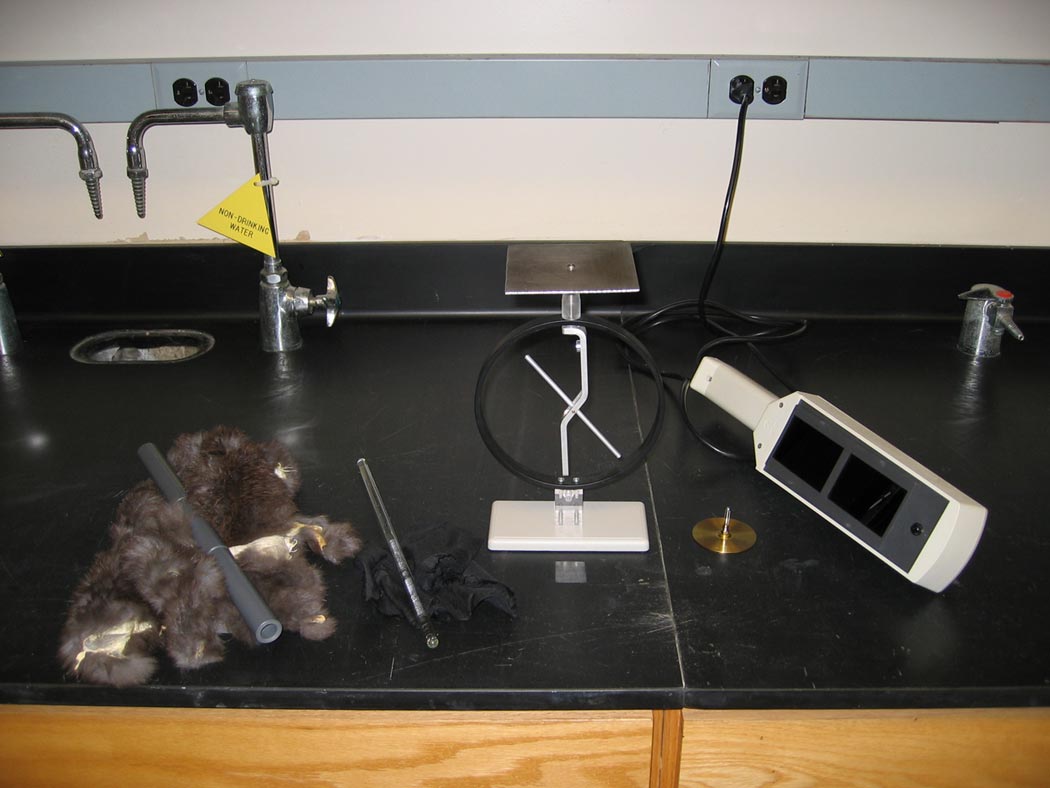The electroscope and Einstein's theory of the photoelectric effect
 An electroscope is charged. When irradiated with light, its total charge is conserved. When the frequency of the light is varied, the electroscope discharges.
An electroscope is charged. When irradiated with light, its total charge is conserved. When the frequency of the light is varied, the electroscope discharges.
Ingredients: electroscope, long and short wavelength UV light source, plastic rod, "fur"
Procedure: A complete recipe follows.
1. An electrical charge is collected on a plastic rod by rubbing the rod against "fur."
2. The charge is transferred to an electroscope, causing the needle to be displaced from its vertical resting position.
3. The electroscope is irradiated with long wavelength UV radiation, and the electroscope is observed.
4. The electroscope is irradiated with short wavelength UV radiation, and the electroscope is observed.
Understanding: The electroscope is a device that is used to register the existence of excess electrical charge. When the electroscope is neutral, the needle is in a vertical position. When the electroscope is charged, or when it is brought near a charged object, the needle is displaced from the vertical to a diagonal position. The needle maintains that position until the charge on the device is changed.
When the electroscope is charged, the top plate is charged, the supporting frame is charged, and the needle is charged. And they all assume the same charge, either positive or negative. As such, the needle will be repelled from the frame of the electroscope. It will move into a diagonal position where the force of gravity, pushing the needle to a vertical position, is exactly balanced by the electrostatic repulsive force, pushing the needle away from the upright support of the frame.
The idea of this experiment is to use light to free the excess electrons from the charged electroscope. Some amount of energy will be required to free the electrons which are attracted to the electroscope. We will try to free them using light.
When the electroscope is irradiated with long wavelength UV radiation, there is no change in its charge. That will be true no matter how intense the light is! That is hard to understand, as the classical theories of light state that the energy in the light is related to the square of the amplitude of the electromagnetic wave. When the intensity of the light is increased, more energy is delivered to the electroscope. Surely if we continue to increase the intensity of the light we will have enough energy to free the excess electrons on the electroscope. Not true!
When the experiment is repeated using short wavelength UV radiation, the needle is seen to slowly relax to its vertical position. The short wavelength radiation does free the electrons from the electroscope. It turns out that can happen even when the intensity of the light is very low. How can that be?
Einstein's theory of the photoelectric effect and the concept of the "photon"
In 1905, Albert Einstein considered this problem carefully. He remembered that Planck had proposed the proportionality of energy and frequency. So he proposed that light of a given frequency was composed of "packets" of energy called photons and that the energy of a photon was determined by the frequency of the light
Ephoton = hν
Applying the principle of conservation of energy we find
Elight = work to free electron + excess kinetic energy of electron
hν = Φ + mv2/2 = hν0 + mv2/2
ν0 = Φ/h
Ephoton = hν = hc/λ
The philosopher of science Thomas Kuhn has argued that Planck did not have a clear conceptual understanding of the implication of his conjecture that the frequency of light is proportional to its energy. It remained for Einstein to make that conceptual leap in understanding.
It is interesting to note that in his nomination of Einstein for membership in the Prussian Academy of Sciences, Planck wrote that the Academy should overlook Einstein's theory of the photoelectric effect as he held it in suspicion. Ironically, it was for his theory of the photoelectric effect that Einstein was awarded the Nobel Prize in Physics in 1921.
You can check your answers here.
The photoelectric effect and the ionization of atoms
Question:
The theory of the photoelectric effect can be extended to the study of the ionization of atoms. The energy required to ionize a hydrogen atom is 13.6 electron-volts. What is the threshold frequency, ν0, for the ionization of hydrogen, in units of Hz.